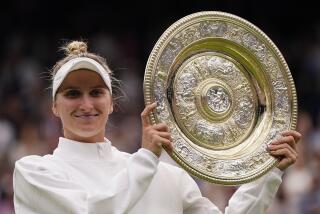Sorry, Steffi: but the ‘80s Belonged to Martina
- Share via
After losing the U.S. Open final in 1981, Martina Navratilova cried.
It wasn’t so much that she had fallen to Tracy Austin or that her career seemed to be sputtering, but that the crowd of her adopted country was giving her a warm ovation.
Navratilova, The Associated Press’ Women’s Tennis Player of the 1980s, has achieved far more than walls full of silver trophies and a financial portfolio packed with prize money.
She has a secure place in tennis history and a life of her own choosing, far from the restrictions and taboos of her native Czechoslovakia.
At the Fort Worth, Texas, home she shares with Judy Nelson, Navratilova’s bedroom is filled with the cups and bowls and plates from major victories.
Nelson says she began collecting the pieces after finding that Navratilova had left them scattered among friends, agents, storage lockers and strangers. More important to Navratilova is simply the winning, especially winning Wimbledon, which she’s done eight times.
“Wimbledon is like a drug,” she said earlier this year. “Once you win it, you’ve just got to do it again.”
Navratilova had already achieved a fair amount of success--winning two Wimbledon singles titles--in seven years as a pro before the start of the 1980s.
That, however, was only a hint of what she would do in the next 10 years as she fiercely ruled women’s tennis most of the decade and became the game’s biggest money-winner--male or female--with more than $15 million in career earnings.
Between 1981 and 1987, she won 15 Grand Slam tournaments--the Australian three times, the French twice, the U.S. Open four times and Wimbledon six times.
She had winning streaks of 74 and 58 straight singles matches and won three Grand Slam doubles with Pam Shriver.
Navratilova’s success in the 1980s is a tribute to her dedication to a rigorous training program that transformed her from a pudgy teen-ager to a taut, muscular athlete with a big left-handed serve-and-volley style.
Weightlifting, sprints, basketball, hours of practice each day on the tennis court--they’re part of the price Navratilova pays for her success.
Sore muscles, injuries, mental fatigue and pressure from fans and the media are an additional price.
She surrounded herself with a team of coaches, including basketball star Nancy Lieberman for fitness and tennis player Renee Richards for strategy.
The pressure Navratilova always put on herself to win increased as the years went by. It remains very much in her mind.
“Pressure grows simply with experience,” she has said. “When you’re a kid, you don’t feel it; you just hit the ball. When you get older, it means more. And there’s much more to control because you know so much more.”
Navratilova, 33, knows the end of her career is near. The women’s tour is lonelier for her without longtime friend and rival Chris Evert, who recently retired.
The gap grows every year between Navratilova and the new teens on the tour, some of whom are half her age.
Steffi Graf, who swept the Grand Slam events last year at 19 and won three of four this year, is the dominant player now.
Nelson says Navratilova has struggled for two years to finish her career with a big win. She failed at Wimbledon last summer, but is expected to try again.
If she’s successful, the next step could be a permanent vacation at their home in Aspen, Colo., where they recently bought another 100 acres. Horseback riding and skiing, Navratilova says, are on her agenda--as soon as she takes care of some unfinished business.
More to Read
Go beyond the scoreboard
Get the latest on L.A.'s teams in the daily Sports Report newsletter.
You may occasionally receive promotional content from the Los Angeles Times.










